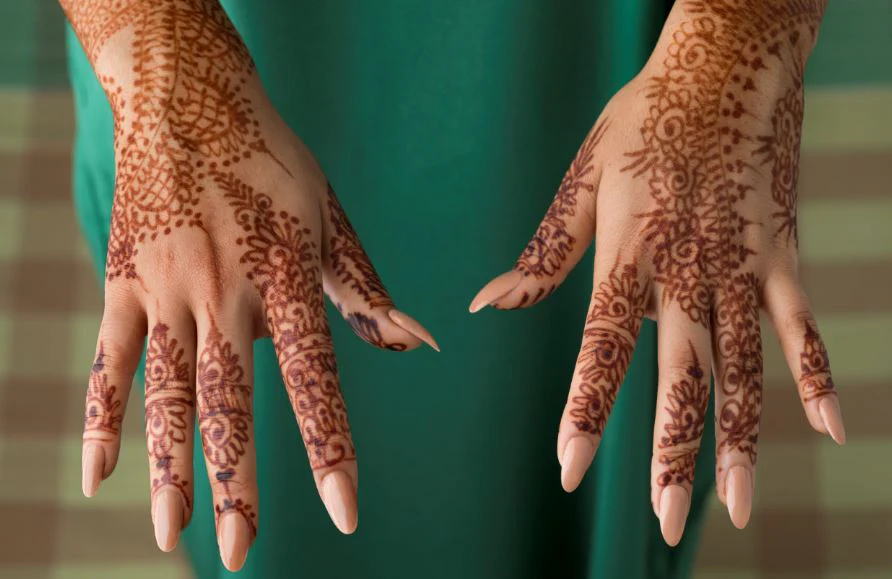What is Henna?
Henna is a plant that grows in hot climates; its scientific name is “Lawsonia inermis”. Lawson, a plant dye contained in its leaves, has been used for centuries to colour textiles, skin, and hair. Henna has a deep cultural history and is often associated with festivals and rituals worldwide, particularly in the Middle East, North Africa, and South Asia.

History of Henna
Tattooing with henna has a millennium-long history, having its roots in the ancient cultures of North Africa, South Asia, and the Middle East. Its origins can be found in ancient Egypt, when it was used as a fabric, hair, and skin colour as well as for its cooling qualities. Henna grew intricately entwined with customs and cultural activities over time, especially in areas like Pakistan, India, and the Arabian Peninsula. It became significant during weddings, festivals, and other events since it was thought to bestow good fortune, protection, and blessings upon the wearer.

Henna became a medium for artistic expression in all of these nations, with talented artists creating elaborate designs full of cultural allusions and meaning. Henna was a common emblem of beauty, fertility, and auspiciousness, used in ceremonies and rites of passage ranging from South Asian weddings to North African celebrations. Henna tattooing has expanded beyond its historical confines in recent decades, becoming a widely accepted temporary body art style. Henna artists nowadays are still innovating and experimenting, fusing old methods with contemporary inspirations, sharing their works on social media, and influencing fashion trends. As a result, the history of henna tattooing is proof of its continuing appeal and cultural significance, enthralling and engaging people all over the world.
Tattooing Henna:
It’s known as mehndi, or henna tattooing, when henna paste is applied to the skin to make transient designs. These patterns range in intricacy from simple patterns to intricate motifs, and they can be applied to the hands, feet, arms, and other body parts.

Maintenance Procedure:
As it dries, the henna paste starts to solidify and crack. During this time, the lawsone molecules in the henna penetrate the epidermal layers and produce a stain. The longer the paste is applied to the skin, the darker the stain will get. After a few hours, the dry paste is carefully removed to reveal a reddish-brown stain underneath.

Length and Follow-Up:
Henna tattoos are transient in nature and often disappear after one to three weeks, contingent upon the skin type, location, and degree of upkeep. For twenty-four hours following application, it is imperative to keep the tattoo out of the water and to moisturise the skin.

Culture and Symbolism:
Tattoos made with henna hold significant cultural value in numerous communities. They are often associated with celebrations and significant life events such as festivals, marriages, and religious rites. Different cultures have different symbolic meanings for henna tattoos, which can include luck, fertility, protection, and more.

Recent Trends and Popularity:
In recent years, henna tattoos have become more and more commonplace throughout the world as a means of self-expression and body art. You may usually find henna stalls during fairs, music festivals, and cultural gatherings. Professional henna painters are also always innovating new techniques, styles, and designs that fuse traditional themes with modern inspirations.

Conclusion
In conclusion, henna tattooing is a classic and seductive artistic method that has been employed for aeons in a variety of cultural settings. This natural dye, derived from the henna plant, creates delicate and fleeting designs on the skin by utilising simple to complex motifs. Henna tattoos have a deep cultural significance and are often associated with festivals, celebrations, and rites of passage.
Applying henna to the skin involves expertly mixing henna powder, water, and additional ingredients to form a paste, which is then applied to the skin in the desired pattern. An initial reddish-brown stain is left by the paste, which darkens as it dries. A beautiful technique to adorn the body and express creativity is with henna tattoos.
Whether for weddings, festivals, or just for fun, henna tattooing, which blends traditional ethnic practices with contemporary artwork, never fails to captivate people around the globe. If you want to celebrate and express yourself, whether it’s by embracing your cultural heritage or just playing with your own style, henna tattoos provide a temporary canvas.


